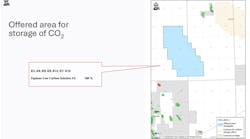David Paganie • Houston
The other Gulf of Mexico: Pemex sees potential in Mexican sector
Pemex is accelerating its exploration and production strategy in the Mexican sector of the deepwater Gulf of Mexico with the objective of reversing Mexico’s declining crude oil production, explains Carlos Morales Gil, general director of Pemex E&P.
Currently, two deepwater rigs are working offshore Mexico, with a total of five expected by 2012, Morales says. Three of the rigs will be capable of drilling in up to 10,000 ft (3,048 m) of water.
Mexico’s flagship oil field, Cantarell, peaked in 2004 and has been rapidly declining. Pemex is confident it can sustain its target oil production output of about 3.4 MMb/d, through an accelerated deepwater exploration and production program, and with the help of IOCs, NOCs, and service companies, Morales says.
“We have not gone into deepwater because we have huge reserves onshore and in shallow water. The issue is in the last 30 years, Mexico depended heavily on the Cantarell field. We slowed down our exploration and that was not the correct strategy. We want to get into this (deepwater) new exploration frontier very fast and efficiently.”
Pemex estimates that Mexico holds potential resources of about 52 Bboe, 57% or 29.5 Bboe are in deepwater. The company has identified a strong correlation among natural hydrocarbon emissions, discovered fields, and identified leads and prospects in the 500-3,000 m (1,640-9,843 ft) water depth range, Morales says.
In 2003 to 2005, Pemex shot seismic and used the data to define its exploration strategy. The company identified 1,700 exploration targets (90% are onshore or in shallow water) in Mexico, Morales says.
In deepwater, Pemex has identified five geological trends over 500,000 sq km (193,051 sq mi) in 500 m (1,640 ft) water depth or greater. They include Subsalt Belt, Perdido Folded Belt, Mexican Ridges, Gulf Salt Province, and Catemaco Folded Belt. In the Perdidio Folded Belt, Pemex has identified leads on the Mexican side which it says have turbidite sands from Oligocene and Eocene similar to the Great White and Trident discoveries on the US side. Great White is about 8 mi (13 km) from the Mexican border.
The main source rocks for oil in the target geological basins offshore Mexico are Upper Jurassic age, while those for gas are Jurassic to Tertiary age, Morales says.
Eight wells in greater than 500 m water depth were drilled from 2003 to 2008: Chuktah (512 m [1,680 ft]), Nab (680 m [2,231 ft]), Noxal (935 m [3,068 ft]), Lakach (988 m [3,241 ft]), Lalail (805 m [2,641 ft]), Chelem (810 m [2,657 ft]), Tamil (778 m [2,552 ft]), and Tamha (1,121 m [3,678 ft]). Three of the wells hit gas pay; two struck heavy oil. Its latest deepwater discovery, Tamil, was drilled in 2008.
To improve its probability of success in deepwater, Pemex is investing in new technology in a number of areas, with emphasis on improving seismic acquisition and processing.
“We have to apply new technology to reduce risk, which is one of our main objectives in deepwater,” Morales says. Pemex has acquired 2D seismic in deepwater and plans to continue its 47,000-sq km (18,146-sq mi) acquisition program over the next three years. The company plans to shoot wide azimuth to obtain better imaging through salt canopies.
New mooring requirements improve MODU performance
New requirements for enhancing mooring of MODUs in the Gulf of Mexico are contributing to improved performance during hurricanes, according to Lars Herbst, MMS GoM regional director. In 2008, two rigs or 15% of the fleet in the GoM went adrift. This is down significantly from the 19 rigs or 63% of the fleet that were moved off location in 2005. MMS says the improvement is the direct result of fitting MODUs with additional mooring lines, the type of new mooring line and anchor, and risk assessment.
For this year’s hurricane season, MMS has issued a number of Notice to Lessees and Operators (NTLs) for guidance.
NTL No. 2009-G10, effective June 1, is for guidance on preparing an application to drill with a jackup in the GoM during hurricane season. The application must demonstrate that the rig is capable of performing at the proposed location. MMS will use the recommendations inAPI’s Recommended Practice 95J, Gulf of Mexico Jackup Operations for Hurricane Season – Interim Recommendations, First Edition (API RP 95J), to guide its review and evaluation. Failure to follow the recommendations may delay the approval of an APD or result in disapproval, MMS says.
NTL No. 2009-G10 covers all jackup rigs that will be used to drill, complete, or workover a well under an APD or APM. The jackup information required for permitting a well during hurricane season relates primarily to foundational issues addressed in the pre-loading process and determination of the appropriate air gap for a specific well location. Information regarding procedures to secure and protect wells in open water locations when the rig is secured prior to hurricane evacuations is also required.
NTL No. 2009-G08, also effective June 1, requires outfitting all MODUs with global positioning system (GPS) transponders by July 1. The GPS systems will provide MMS with real-time information on the location and path of a MODU in the event that it is displaced due a storm.
Technip wins deepwater contracts
Bluewater Industries has awarded Technip two lumpsum contracts for work on the Telemark and Clipper Corridor field developments in the deepwater Gulf of Mexico. Both contracts involve risers, umbilicals, flowlines, and associated subsea infrastructure.
Offshore installation is scheduled for late 2009/early 2010 for the Telemark project and 2Q 2010 for the Clipper Corridor project, using the deepwater pipelay vesselDeep Blue. The Deep Pioneer also will participate in the Telemark project.
Technip also picked up a contract from Shell to deliver a gas lift flowline and a steel catenary riser for the Princess project. The field is tied back to the Ursa TLP in Mississippi Canyon block 809. Offshore installation will be carried out by Deep Blue.




